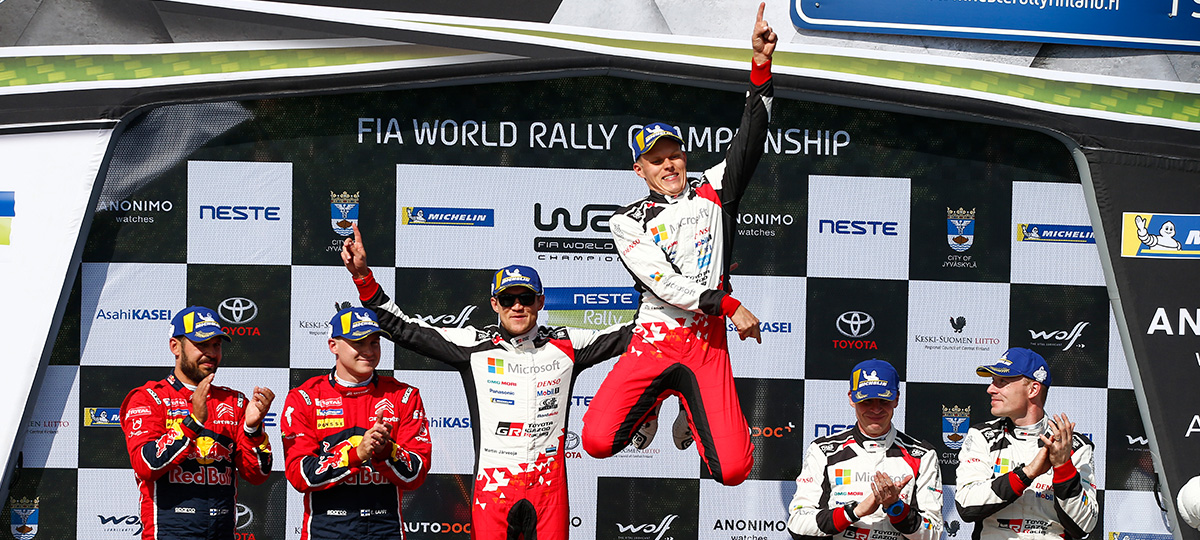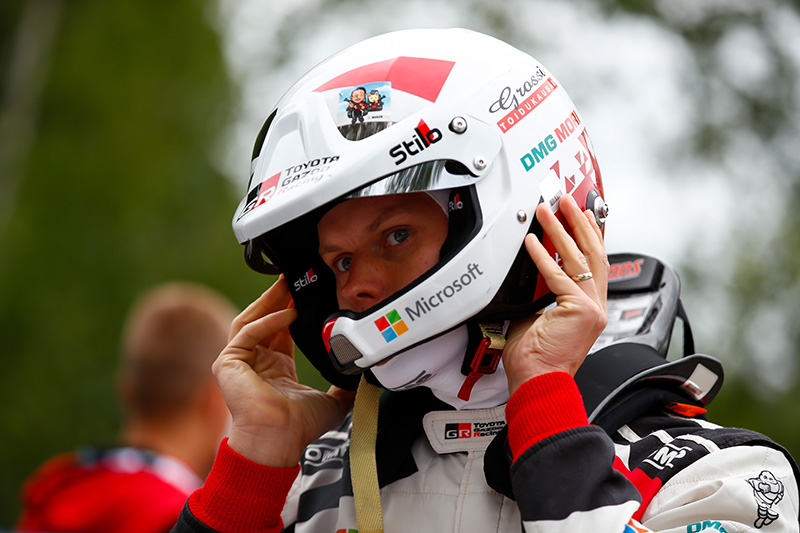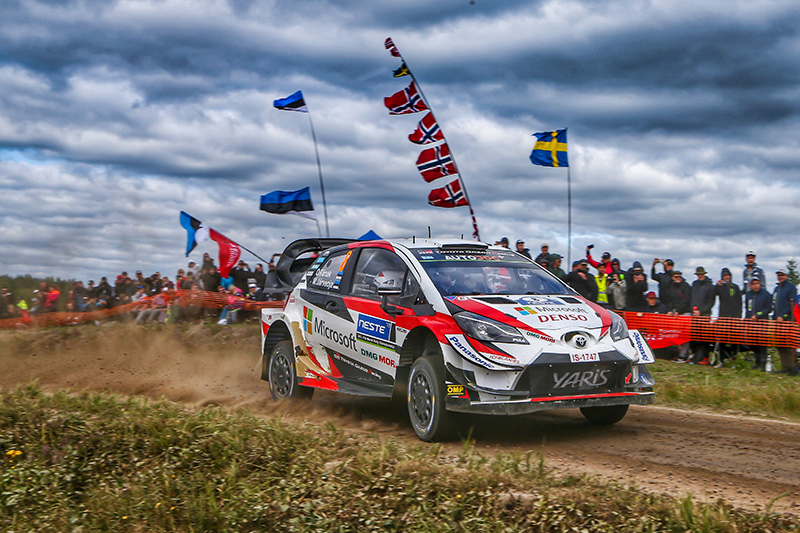2019 Rd.9 RALLY FINLAND
WRC 2019 ROUND 9 RALLY FINLAND

SUMMARY REPORT
TOYOTA GAZOO Racing secures a double podium finish for the third year in a row
For the TOYOTA GAZOO Racing World Rally Team, the previous round—Rally Italia Sardegna—was extremely heartbreaking. Ott Tänak was almost certain to win the rally but his power steering failed in the final Special Stage, and he ended the rally frustratingly in fifth position. The team had focused on improving the reliability of the Yaris WRC almost as much as they had on improving its performance; team members paid attention to each individual part, and took the greatest care over assembly. Yet despite their best efforts, the car suffered unexpected issues.

But what, exactly, happened at Sardegna? The team’s engineers immediately began looking for the cause of the issues; they conducted a thorough investigation of the broken power steering systems, and discovered a small defect in one of the component parts. The power steering systems contain a large number of parts, and are delivered to the team by its supplier in a pre-assembled state. Although previously the team carried out rigorous quality management on the pre-assembled systems, it did not carefully examine each component part; the reason was that, until Sardegna, this approach had not resulted in any issue. However, after its misfortune at the previous rally, the team chose to begin quality management of each individual component part. The team did not want its drivers to experience such disappointment again. Full of regret, the team’s engineers focused on making improvements in the run up to Rally Finland, which was to begin in six weeks’ time.

Round 9, Rally Finland, was the TOYOTA GAZOO Racing WRT’s home event. The team had secured first-third finishes in both 2017 and 2018, and it was a rally at which they always performed well. The Yaris WRC was developed at the team’s Finnish factory and refined on Finnish roads; indeed, the car excels on Finland’s distinctive, hard-packed, high-speed gravel roads, and both the team and the drivers were full of confidence. However, their rivals were also evolving at a fierce pace; if the team’s rate of development slowed even a little, its advantage would disappear instantly. In addition, Rally Finland is an event where it is difficult to open up large time gaps, with drivers often fighting over narrow margins of tenths of a second to the very end. For this reason, the team focused not only on improving the Yaris WRC’s reliability, but also its performance.

It was the engine that underwent the greatest evolution at Rally Finland. Finland is the fastest rally on the WRC calendar, meaning that in addition to torque at low and medium engine speeds, power at high engine speeds is also crucial; indeed, this has a major effect on raising the speed of the car. Toyota Motorsport GmbH (TMG) in Germany is in charge of developing the Yaris WRC’s 1.6-liter direct-injection inline four-cylinder turbo engine; since the car’s debut season in 2017, TMG had continued to make steady improvements. To begin with, team drivers indicated that the engine lacked torque; however, following a series of improvements, TMG succeeded in increasing torque satisfactorily. The company next further increased the power of the engine, then again boosted its torque; in this way, it alternated between raising the engine’s power and torque—two elements which it is difficult to balance. In Finland, TMG delivered an updated engine, with improvements that focused on power. The aim of the update was to improve performance on Finland’s high-speed gravel stages.

With regard to the Yaris WRC’s suspension, the team basically followed precedent with last year’s package and settings, as Tänak and the other drivers had driven with confidence in the car’s handling. Of course, team engineers had prepared new settings with the expectation of making further improvements. In the end, however, the 2018 setup provided superior balance, and the team opted not to make changes for the sake of change. Driver confidence is of the utmost importance during rallies, since the conditions of both corners and road surfaces are constantly changing. Even if a setup provides maximal performance for a short time, time improvements cannot be expected if the car is difficult to control; there is also a heightened possibility that this will lead to driving errors. When it comes to handling, the most important thing is that drivers can drive in a relaxed manner—and, as far as Finland was concerned, the 2018 setup guaranteed this. For this reason, the team deliberately chose not to make significant changes.

The team started Rally Finland fully prepared, and the efforts of both the team and its drivers were rewarded early on. The genuine forest stages began on August 2. On the day’s first stage—SS2—Jari-Matti Latvala recorded the fastest time; on SS3, Kris Meeke went fastest, with Latvala quickest again on SS4. From the start, the speed of the Yaris WRC stood out. As championship leader, Tänak had the disadvantage of starting first in the running order; nevertheless, his times were consistently among the best, and he led the rally standings by the end of SS2. He then went fastest on SS5—a superb start to his Rally Finland.

The road surfaces had deteriorated by the time of the day’s afternoon reruns, and Tänak lost a little speed. Latvala, on the other hand, redoubled his efforts and set the fastest time in three out of the afternoon’s five stages. The battle for the rally lead between the two teammates was fierce, but it was Latvala who ended the day on top. Although Meeke only won one stage, he reliably set a succession of fast times to finish in second overall, 1.2 seconds behind Latvala. Tänak completed the day’s stages in fourth in the rally standings, with a gap of just 0.2 seconds to his rival in third. In fact, since the gap between Tänak in fourth and Latvala in first was only 2.6 seconds, all three Yaris WRCs ended the day in positions from which they could aim for the podium.

On August 3, Tänak was no longer disadvantaged by his position in the running order and showed increased speed. He went fastest on the opening SS12 and assumed the rally lead. However, it was Meeke who was quickest on SS13, and Latvala reclaimed the rally lead with the second fastest stage time. The gap between Latvala in first and Tänak in second was 0.2 seconds. Meeke, in third, was just 0.6 seconds behind Latvala as well—the battle for first was extremely tight, and the tension made the rally incredibly exciting.

However, there was drama on SS14: both Latvala and Meeke went off course at the same right-hand corner, colliding with a large rock in a ditch. Latvala damaged his wheel and bodywork, and finished SS14 approximately 14 seconds behind Tänak, who won the stage. Latvala had dropped off the lead, but he remained in second overall. The situation was not so positive for Meeke; after damaging his suspension, he was unable to continue and had to retire for the day. The team’s ambition to secure all three podium positions proved short-lived.

There can be little doubt that the fierce battle between the three teammates prompted Latvala and Meeke to drive off course. However, the presence of drivers from other teams, who also had the speed to break into the fight for the podium, pressured Latvala and Meeke into attacking and exceeding their limits as well. Indeed, it was a former TOYOTA GAZOO Racing WRT driver—the winner of the 2017 Rally Finland in the Yaris WRC—who was particularly fast. Latvala struggled to find the optimal balance between speed and caution, and was forced to concede second place in the rally standings to his rival. Tänak in first place was also unable to let his pace drop, and a breathtaking battle continued to the very end of the day. Yet, the Estonian succeeded in extending his lead over second place to 16.4 seconds, and so moved to the penultimate step before claiming a second successive Rally Finland victory.

The final day of Rally Finland comprised four Special Stages, with a total distance of just 46 kilometers or so. However, if Tänak made a large mistake, there was the possibility of being overtaken; and if the Yaris WRC suffered mechanical issues—like it did in the previous rally—victory might also be lost. For this reason, the team made a careful check of the cars, and Tänak himself ensured he was fully focused for the final day’s stages. On the first stage of the day, SS20, Tänak recorded his fifth fastest time of the rally; this was Tänak’s 50th stage win of the season, the Yaris WRC’s 120th, and a remarkable 200th stage win for the team since its return to WRC.

Tänak increased the gap to his rival in second to 20 seconds, and became increasingly confident of victory. He therefore changed his strategy. On the following two Special Stages, the Estonian reduced his pace; his priority was to ensure he made no mistakes and to save his tires. Then, on the final Power Stage, on which bonus championship points were awarded, Tänak attacked fully: he succeeded in recording his sixth stage win of the rally, and secured the maximum available five bonus points. Combined with the 25 points he received for winning Rally Finland, Tänak accumulated a total of 30 championship points, and so significantly increased his lead at the top of the drivers’ championship. For Tänak, this was the perfect result, and he was finally able to erase his disappointment from Sardegna. The engineers, who had been watching the drivers battle from the service area, were also liberated from the heavy atmosphere that had weighed down on them for the past six weeks. The Yaris WRCs had completed Rally Finland without suffering any mechanical issues, and so the engineers were finally able to shake the hands of the drivers with smiles on their faces.

Tänak commented: “For the entire weekend, the car was perfect. Both my teammates and my rivals were fast, and we engaged in a fierce battle over fractions of a second. However, I am delighted to have won. When I won here last year, it was my second victory of the season; this year it is my fourth. Thinking of it that way, you can say that we are in a good position. However, my rivals are extremely powerful, and they will certainly come back stronger, so we cannot relax. Unless we continue attacking, I think it will be impossible to win the title.” With his fourth victory of the season, Tänak equaled his best ever haul of wins; however, this was nothing more than a stepping stone for the Estonian.

On SS21, Latvala won his eighth stage of the rally to close the gap to his rival but, in the end, he was unable to secure second place. Nevertheless, Latvala’s third-place finish was his best result of the season so far, and was his first podium finish since the season-ending Rally Australia in 2018. The Finn said: “It has felt extremely long. I thought I would be unable to recover, but I have finally managed to regain my confidence.” Latvala’s third-place finish was also extremely significant for the TOYOTA GAZOO Racing WRT; it helped them accumulate a large number of manufacturers’ championship points, and there is now renewed hope that the team can defend its title. However, the team cannot be fully satisfied with finishing first and third for the third year in a row since, on August 3, two of its drivers who had been fighting for the rally lead went off course, hit the same rock, and lost the opportunity for victory.

Looking back over the course of the season, there have been a number of times when Latvala and Meeke’s driving have led to difficulties in critical situations. However, this is not solely due to their driving ability; if they had been aware of the dangers of the course-side rocks in advance, for example, would they have taken a lower-risk approach to the corner? During the recce, when the drivers draw up their pacenotes, perhaps the drivers had overlooked the presence of dangerous stones and tree stumps. How, then, can the drivers be encouraged to make more accurate recces? It is not just about improving the car; it should be possible for the team and its drivers to work together to improve both the driving and the pre-rally recces in a scientific manner. Maximizing the driving potential of its drivers in this way is another important area of research for the team.

| Pos | Driver | Co-Driver | Vehicle | Time | |
|---|---|---|---|---|---|
| 1 | Ott Tänak | Martin Järveoja | Toyota Yaris WRC | 2h30m40.3s | |
| 2 | Esapekka Lappi | Janne Ferm | Citroën C3 WRC | +25.6s | |
| 3 | Jari-Matti Latvala | Miikka Anttila | Toyota Yaris WRC | +33.2s | |
| 4 | Andreas Mikkelsen | Anders Jaeger-Amland | Hyundai i20 Coupe WRC | +53.4s | |
| 5 | Sebastien Ogier | Julien Ingrassia | Citroën C3 WRC | +56.1s | |
| 6 | Thierry Neuville | Nicolas Gilsoul | Hyundai i20 Coupe WRC | +1m32.4s | |
| 7 | Craig Breen | Paul Nagle | Hyundai i20 Coupe WRC | +1m38.2s | |
| 8 | Teemu Suninen | Jarmo Lehtinen | Ford Fiesta WRC | +2m33.8s | |
| 9 | Kalle Rovanperä | Jonne Halttunen | Skoda Fabia R5 Evo | +7m54.1s | |
| 10 | Nikolay Gryazin | Yaroslav Federov | Skoda Fabia R5 | +10m28.7s | |
| R | Kris Meeke | Seb Marshall | Toyota Yaris WRC | R |
- RELATED TOPICS
-
-
TOYOTA GAZOO Racing World Rally Team
launches 2019 challenge at the Autosport International showThe 2019 FIA World Rally Championship season has been launched today in front of thousands of motorsport fans at the Autosport International show in Birmingham, England. TOYOTA GAZOO Racing World Rally Team is in attendance with its manufacturers’ championship-winning Yaris WRC car and its full squad of drivers and co-drivers. -
WRC 2019 ROUND 9 RALLY FINLAND Gallery
-
TOYOTA GAZOO RACING GLOBAL
WRC GLOBAL
WEC GLOBAL





